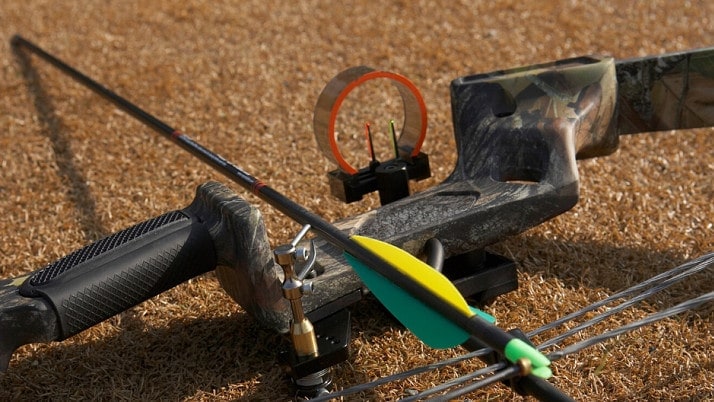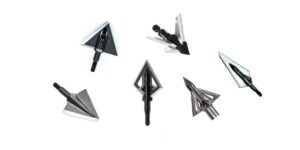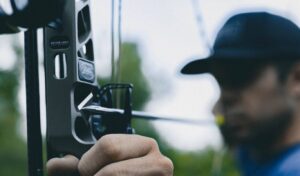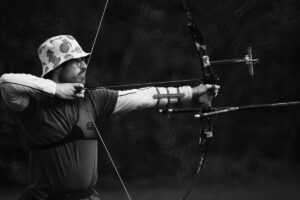A lot of bows in today’s market are equipped with basic cable slides. To reduce friction while drawing and releasing, even more, make sure to replace your worn-out slides with something top-notch.





Based on our research, we compiled a list of buying suggestions for cable guides and cable slides. Based on customer reviews, here are the products that we recommend.
Cable Slide VS Roller
In order for a compound bow to function as designed, several individual components must all perform flawlessly, operating in harmony with one another.
A bow of this nature relies upon the mechanical advantage provided by one or more cams, to transfer stored kinetic energy from a bow’s limbs to an archer’s arrow.
However, several additional components play key roles in facilitating this action, many of which are often forgotten.
One such often overlooked yet pivotal component of a compound bow is the cable guide. While relatively simple by design, the cable guide serves a vital function, ultimately preventing the misrouting of a bow’s buss cables.
However, many archers are still left with a certain level of confusion when determining which type of cable guide is right for their particular application.
In the following guide, we will discuss the value of a compound bow’s cable guide, while also delving into the key differences between guides of a cable slide and roller design.
At a Glance: Here are the Top Cable Slides for Compounds
Contents (Jump to Topic)
ToggleTop Tier Cable Slides 2025
BEST OVERALL – Saunders Hyper Glide Cable Slide
The Saunders Hyper Glide Cable Slide replaces any 3/8″ slide. The installation is easy and fast (click-n-shoot).
The ultra low-friction wheel is something you are going to love: The slide is going to be the slickest and smoothest ever.
Features:
- Click-n-Shoot installation
- Extremely low cable wear
- Made in the U.S.A.
- Very good shooting consistency
No more worries about string deformations or fraying. Easy installation – the roller glides up and down the rail without any sticking. Quality made in the U.S.A.
XLZKJ Archery Compound Bow Cable Slide Roller Glide
Made of durable aluminum, this slider is going to last. The low-friction wheel will help you experience a smooth and slick slide.
If you want to protect your bowstring from excessive wear, this will help. Easy to install and remove.
Features:
- Durable Aluminum Alloy
- Easy to install and remove
- Helps to reduce excess firing noise
The cable slide is available in two colors: Black and Red. Enhances cable movement during draw and release cycle.
Carbon Express Teflon Universal Cable Slide
This universal cable slide replaces any 3/8″ slide. The special Teflon construction helps to eliminate noise and friction.
It´s easy to install and once it is in place, it helps to reduce the wear of your string.
Features:
- Fits any 3/8″ cable guard rods
- Special Teflon construction ensures an easy glide surface
- Teflon is ultra-strong and long-lasting
It can be used on either right or left-handed bows. Helps to eliminate friction and unwanted noise.
HRCHCG 3/8″ Aluminum Roller Glide
The HRCHCG is made of aluminum and is applicable to any 3/8″ cable bar. This is a roller-glide and it is fast and easy to install.
It helps to reduce excessive firing noise, provides highest shooting consistency in combination with extremely low cable wear.
Features:
- Made of aluminum
- Works on bows with a 3/8″ cable rod
- Ultra-low friction wheel
Available in three colors: Black, Red, and Blue.
Precision Shooting Equipment (PSE) Cable Slide 44
PSE is a well-known name in the archery industry. This cable guard rod slide will fit 3/8″ rods. It is made of plastic and probably the most basic cable glide on our list.
It does what it is supposed to do. Not much to say. So far I have not used it myself, but from what customers are saying, it works well, nice, and smooth.
Features:
- PSE Cable Slide
- Comes in one color: Black
- Made of plastic
- Fits a 3/8″ cable rod
This might be for you if you don’t want to spend a fortune. PSE is a well-known supplier and stands for quality. Might as well give it a try.
Types Of Cable Guides
Cable guides come in two main varieties, including those of a roller design, and those consisting of a cable slide. Both of these types of cable guide function satisfactorily in the bulk of situations, though each design carries its own distinct set of advantages.
The following is a general description of each of the two main types of cable guides currently available.
Cable Slide
A cable slide mounts to a bow’s cable guard rod and retains a bow’s buss cables at a slight offset. Cable guides of this type are reliant upon a buss cable’s ability to slide within its confines, throughout an archer’s draw cycle.
Typical cable slides served as the “industry standard” for many years, though this is not always the case today. Many premium compound bows now come stock with roller cable guides, while a few companies still opt for the use of cable slides.
Roller Guide
Over the past decade, a number of new roller-style cable guides have risen to prominence. These roller guides are affixed to a rear-facing guide rod and feature specialized rollers. The exterior surface of these rollers includes a subtle intent, or track, on which a bow’s cables ride.
As a bow is drawn, these rollers pivot, allowing the bow’s cables to effortlessly feed as needed. As such, resistance is minimized on a bow’s buss cables, though proper retainment is still facilitated. Some archers find this characteristic to be rather valuable in nature.
Effects On Cable Wear
When deciding between the use of a cable slide or roller string guide, the notion of cable wear is often discussed. This, of course, is for good reason, as like a bow’s string, buss cables do occasionally wear to the point of requiring replacement.
As many archers are aware, the use of traditional cable slides does eventually lead to localized buss cable fraying and wear. This occurs even when a bow’s buss cables have been adequately waxed, and protected from additional sources of wear.
This wear comes as the result of friction, which occurs between a bow’s cables and the cable slide itself, during the draw cycle. On the other hand, the use of a roller cable guide eliminates this friction at its source, as a bow’s buss cables are fed along rollers, rather than slid repeatedly.
Effects On Bow Speed
A number of archers also fancy the idea of roller guide use, due to the perceived increase in speed that such equipment is said to provide. The theory behind this notion is that roller guide-equipped bows should feature faster arrow speeds, as a result of the reduction in friction that is provided by gear of this type. Simply put, roller guides typically exhibit less cable drag than their standard counterparts.
However, to date, there has been little proof that arrow speed is truly affected by an archer’s choice in string guide. Though it is true that roller guides produce less cable friction than roller guides, it appears that this reduction in friction is largely nominal, having no real bearing on arrow speed.
Bow Torque and Cable Guides
Due to the fact that a bow’s cable guard provides a certain amount of buss cable offset, a small degree of torque is imparted upon a bow’s cables/strings. In some instances, this torque can present inconsistencies in a bow’s accuracy, though such impacts tend to be relatively minor. These inconsistencies are generally more noticeable in bows of a shorter axle-to-axle length.
Roller cable guides are often thought of as producing a greater amount of torque, due to their stationery design. This can pose additional challenges when attempting to tune a bow for enhanced accuracy. However, bows featuring cable guards of this variety can still be adequately tuned, by knowledgeable bow technicians.
Cost Considerations
In the vast majority of cases, standard slide-style cable guides are priced more economically than the industry’s latest roller guide offerings. Such fixtures are generally manufactured of plastic and can be readily sourced for less than $10.
On the contrary, the cost associated with roller cable guides typically falls within a range of $15-$50. This difference in price is generally attributed to the additional complexities of most roller guides, over standard plastic cable slides.
While the cost associated with either type of cable guide is certainly mild in comparison to a number of compound bow accessories, it still bears consideration for those minding a rather restrictive budget. In cases of this nature, a slide-style cable guide is likely the best option.
The True Difference
An archer’s choice in cable guide is largely a matter of personal preference. While some might prefer the use of today’s ultra-modern roller guards, other individuals still find satisfaction in the use of cable slides, and the reliability that they offer. Either of these routes is perfectly acceptable, and sacrifice nothing in the way of practicality.
If any factor were to differentiate between these two types of cable guides, it would be that roller guards tend to produce less cable wear than cable slides. However, the trade-off to this is that roller guards are known to impart additional torque upon a bow’s cables and strings. Therefore, archers are left to determine which of these two configurations are best suited to their particular application.
Because of the fact that an increase in speed between either type of string guide has never been substantiated, it is difficult to refer to either string guide design as being “superior”. On the contrary, a quality string guide of either type is sure to serve any dedicated archer well.
What Makes A Good Bow Cable Slide?
When searching for the best cable slide, there are several factors which you should consider:
- Quality
- Ease of installation
- Actual functionality
Which Cable Slide Is The Best?
Useless to say, that you should aim to buy something that’s going to last longer than 20 shoots…
Look for well-known suppliers (as we did) and educate yourself about what other customers had to say (did that for you)

After evaluating and reading through lots and lots of reviews we found that the Saunders Hyper Glide Cable Slide is our recommended product.
Saunders is well known among the archery crowd. Nearly 80 years and three generations of Saunders devoted their lives to archery. As a result, they produce well thought out products that actually work. Period.
If you are in the market for a new cable slide, make sure to check out the Saunders Hyper Glide Cable Slide











Conversation | 2 comments:
Nothing says you tested these cable slides. Ideally, they should all be tested under similar conditions for an extended period, say a year.
Rollers are not aligned with the bus cables, and the cables impinge on the edges of the roller groove. This does cause wear on the strings; one of my cables shows fuzziness after only a few months.
True – I made some changes to reflect the fact that we came up with our suggestions based on external reviews and not first-hand testing.